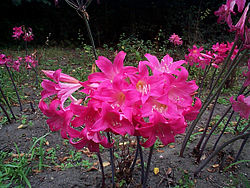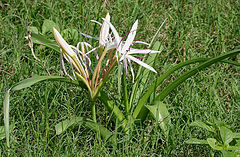- Amaryllideae
-
Amaryllideae Amaryllis belladonna, Isles of Scilly, UK. Scientific classification Kingdom: Plantae Subkingdom: Tracheobionta Division: Magnoliophyta Class: Liliopsida Subclass: Liliidae Order: Asparagales Family: Amaryllidaceae Subfamily: Amaryllidoideae Tribe: Amaryllideae
J.St.-Hil.Subtribes See text.
Diversity 11 genera, ca. 150 species Amaryllideae is a tribe of perennial, herbaceous and bulbous plants in the Amaryllis family (Amaryllidaceae, subfamily Amaryllidoideae). Members of this tribe are distributed in Africa, with the exception of the pantropical genus Crinum. Much of the tribe's generic diversity is confined to South Africa.[1]
Contents
Description
Amaryllideae is marked by a large number of synapomorphies: extensible fibers in the bulb tunics, bisulculate pollen with spinulose exine, scapes with a sclerenchymatous sheath, unitegmic or ategmic ovules, and nondormant, water-rich, nonphytomelanous seeds with chlorophyllous embryos.[2] A few of the genera extend outside of South Africa proper, but only Crinum, with seeds well suited to oceanic dispersal,[3] ranges through Asia, Australia, and America.[4]
Subtribes
Based on the results of a combined cladistic analyses of morphology and DNA sequences, the tribe is generally subdivided in the following 4 subtribes:[5]
- Subtribe Amaryllidinae
- Leaf with a prominent midrib; flowers zygomorphic, without a perigone tube; stamens declinate, proximally connate into a rudimentary filament tube; scape not detaching from bulb during seed dispersal; fruit dehiscent; seeds large, pink or colorless, only the embryo green. Endemic to the winter rainfall region of southern Africa.
- Subtribe Boophoninae
- Leaves spreading into an erect fan. Inflorescence of numerous helicoid cymes; pedicels elongating and radiating after anthesis; flowers actinomorphic, with a perigone tube; stamens free; fruit indehiscent, trigonal, 3-ribbed; fruiting head detaching from top of scape; seeds endosperm-rich, partially chlorophyllous, cork-covered. Widespread in sub-Saharan Africa.
- Subtribe Crininae
- Leaves often with an intercalary meristem, usually fringed with cartilaginous teeth, apex often truncate. Flowers actinomorphic to zygomorphic, with a perigone tube; stamens free; fruit indehiscent, irregular, often rostellate; scape not abscising during seed dispersal except in Cybistetes where it detaches at ground level; seeds lacking an integument, endosperm-rich, partially chlorophyllous, cork-covered. Widespread in the tropics and sub-Saharan Africa.
- Subtribe Strumariinae
- Leaves often prostrate. Flowers zygomorphic or actinomorphic, with or without a perigone tube; stamens connate into a tube proximally (except in Strumaria where one whorl of stamens is fused to the style); fruit dehiscent; seeds with a well-developed chlorophyllous integument and stomatose testa. Southern Africa. Still, there exist controversy about the delimitation of genera in this subtribe.[6]
Taxonomy
- Family Agapanthaceae
- Family Amaryllidaceae
- Tribe Amaryllideae
- Subtribe Amaryllidinae Pax in Engler & Prantl[7]
- Subtribe Boophoninae D. & U.Müll.-Doblies[8]
- Boophone
- Subtribe Crininae Pax in Engler & Prantl[9]
- Crinum
- Ammocharis
- Cybistetes
- Subtribe Strumariinae Traub ex D. & U.Müller-Doblies[10]
- Crossyne
- Strumaria
- Nerine
- Hessea
- Namaquanula
- Brunsvigia
- Tribe Cyrthanteae
- Tribe Hamantheae
- Tribe Calostemmatae
- Tribe Lycorideae
- Tribe Galantheae
- Tribe Pancratieae
- Tribe Narcisseae
- Tribe Griffineae
- Tribe Hippeastreae
- Tribe Eustephieae
- Tribe Strenomesseae
- Tribe Eucharideae
- Tribe Clinantheae
- Tribe Hymenocallideae
- Tribe Amaryllideae
References
- ^ Snijman D. A. H. P. Linder 1996 Phylogenetic relationships, seed characters, and dispersal system evolution in Amaryllideae (Amaryllidaceae). Annals of the Missouri Botanical Garden 83: 362-386
- ^ Meerow A. W. D. A. Snijman 1998. Amaryllidaceae. In K. Kubitzki [ed.], Families and genera of vascular plants, vol. 3, 83–110. Springer-Verlag, Berlin, Germany
- ^ Koshimizu T. 1930 Carpobiological studies of Crinum asiaticum L. var. japonicum Bak. Memoirs of the College of Sciences, Kyoto Imperial University, Series. B., Biology 5: 183-227
- ^ Vigneron, P. (2000-2006). "Amaryllideae". Amaryllidaceae organization. http://www.amaryllidaceae.org/Amaryllideae.htm. Retrieved 2009-06-02.
- ^ Meerow, Alan W., Snijman, Deirdre A. 2001. Phylogeny of Amaryllidaceae tribe Amaryllideae based on nrDNA ITS sequences and morphology. Am. J. Bot. 88: 2321-2330
- ^ Katja Weiehhardt-Kulessa, Thomas Bórner, Jiirgen Sehmitz, Ute Müller-Doblies, and Dietrich Müller-Doblies. 2000. Controversial taxonomy of Strumariinae (Amaryllidaceae) investigated by nuclear rDNA (ITS) sequences. 1. Hessea, Namaquanula, Kamiesbergia, and Dewinterella. Plant Syst. Evol. 223:1-13 (2000)
- ^ Nat. Pflanzenfam. 2, 5: 105. 1887 emend Meerow & Snijman, 2001.
- ^ Feddes Repertorium 107: S. c. 3. 1996 emend Meerow & Snijman, 2001.
- ^ Nat. Pflanzenfam. 2, 5: 108. 1887; Müller-Doblies & Müller-Doblies, Feddes Repertorium 107: S. c. 3. 1996.
- ^ Bot. Jahrb. 107: 18. 1985 emend Meerow & Snijman, 2001.
Further reading
- Snijman, D. A. 1992. Systematic studies in the tribe Amaryllideae. Ph.D. dissertation, University of Cape Town.
- Müller-Doblies, D., and U. Müller-Doblies. 1996. Tribes and subtribes and some species combinations in Amaryllidaceae J. St.-Hil. emend. R. Dahlgren and al. 1985. Feddes Repertiorum 107 (5-6): S.c. 1-9.
- Meerow, Alan W. Michael F. Fay, Charles L Guy , Qin-BaoLi, Faridah Q Zaman and Mark W. Chase. 1999. Systematics of Amaryllidaceae based on cladistic analysis of plastid sequence data. Am. J. Bot., 86: 1325.
- Weichhardt-Kulessa K., Börner T., Schmitz J., Müller-Doblies U. & Müller-Doblies D. 2000. Controversial taxonomy of Strumariinae (Amaryllidaceae) investigated by nuclear rDNA (ITS) sequences. Plant Systematics and Evolution, 223(1-2): 1-13.
Categories:- Amaryllidoideae
- Plant tribes
- Subtribe Amaryllidinae
Wikimedia Foundation. 2010.


